What is a Vial Filling Machine?
Introduction to Vial Filling Machines
In the biotechnology and pharmaceutical industries, vial filling machines are a critical piece of equipment. These machines fill vials with liquids, powders, or semi-solid products in a sterile and precise manner. The process consists of container preparation, dispensing the product, and subsequent sealing or capping.
Vial filling equipment main goal is to reduce contaminations and human errors during the production process. These machines are critical in accelerating the production rate, which is particularly beneficial in the sensitive industry of medicines, vaccines, and healthcare products.
With a diverse product line, King Pack supplies numerous vial-filling equipment, which include automatic, semi-automatic, sterile, and stoppering and capping systems. We can advise on the production needs and the right equipment, which is tailored to your specific project specifications.
Importance in Pharmaceutical and Biotech Industries
The pharmaceutical vial filling machine market is growing fast. In 2024, the market reached approximately USD 1.2 billion and is expected to reach USD 2.5 billion by 2033. This represents a consistent growth rate of around 9.2% each year. This is an indication of the growing importance of vial filling systems in modern drug manufacturing processes.
Such machines are critically important for pharmaceutical companies in the production of essential medicines, vaccines, and complex biologics. The equipment allows manufacturers to comply with the stringent regulations from the FDA (Food and Drug Administration) and other global regulators.
In biotech, sterile vial filling equipment are of great value when filling vials with sensitive materials that must remain uncontaminated. King Pack supports this industry with vial filling solutions that are precisely engineered to comply with stringent regulations and improve production floor efficiency.
Types of Vial Filling Machines
There are different types of vial equipment. Here are the main types:
- Automatic Vial Fillers
- Semi-Automatic Vial Fillers
- Sterile Vial Filling Machines
- Vial Filling and Stoppering Machines
- Vial Filling and Capping Machines
Now, let’s have a detailed look at each of these machines.
Automatic vs Semi-Automatic Vial Fillers
Automatic vial filling machines are built for peak performance. They are highly integrated with high-volume production lines and run continuously. The systems offer high-speed output without sacrificing strenuous accuracy levels.
The following table shows the main specifications of automatic vial filling machines in detail:

On the other hand, semi-automatic vial filling machines provide a functional compromise between automation and manual intervention. They are accurate fillers with increased operator flexibility. These machines suit manufacturing environments where flexibility is more important than pure speed.
The following table shows the main specifications of semi-automatic vial filling machines in detail:
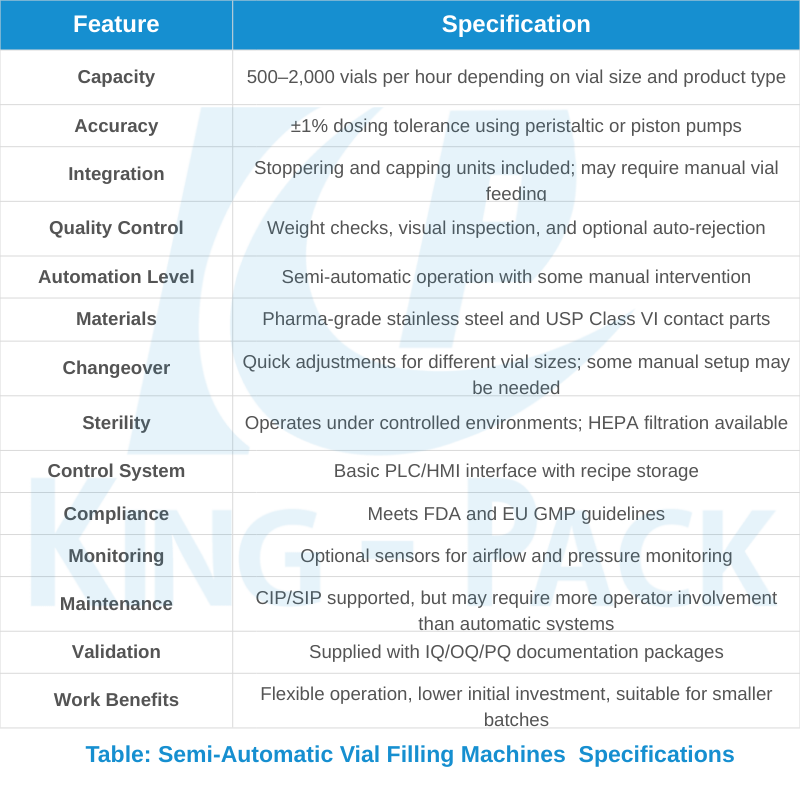
King Pack offers full automatic and semi-automatic versions customized to suit different needs in pharmaceutical and biotech industries.
Sterile Vial Filling Machines
These machines accurately fill drugs into vials and offer encapsulated environments for injectable drugs, biologics, and vaccines that require absolute sterility.
Sterile vial filling machines allow accurate dosing while maintaining product integrity. Such machines also perform stoppering, capping, and nitrogen overlay for shelf life maintenance.
The following table shows the main specifications of sterile vial filling machines in detail:
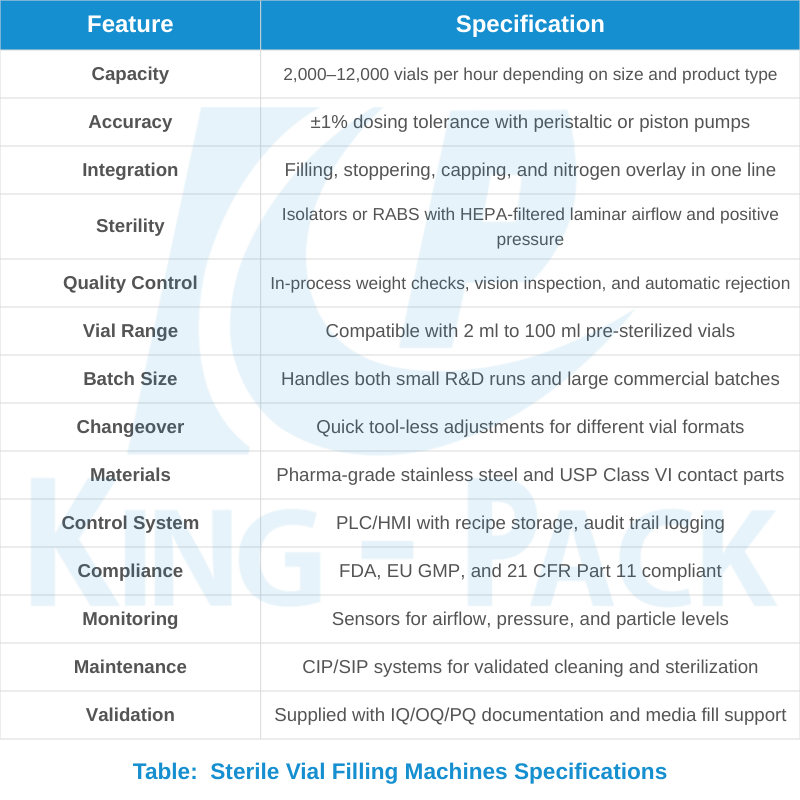
The aseptic filling machinery market is witnessing strong growth worldwide. Valued at around USD 1.3 billion in 2024, it’s anticipated to reach USD 3.4 billion in 2035 with an average annual growth rate of 8.7%. This steady growth indicates how important clean room vial filling technology has become as a part of pharmaceutical manufacturing.
Vial Filling and Stoppering Machines
Vial filling and stoppering machines bring together two critical steps in one system. They fill the product and insert rubber stoppers in a single process. This setup shortens product exposure time and helps lower the risk of contamination.

King Pack’s vial filling and stoppering solutions deliver consistent reliability across various container sizes and stopper configurations.
Vial Filling and Capping Machines
Vial filling and capping machines extend packaging capabilities to include final closure application following initial stoppering operations. These comprehensive systems accommodate aluminum caps, flip-off closures, and tamper-evident seals depending on specific product requirements.
The integrated approach eliminates intermediate transfer steps between separate machines while preserving product sterility throughout the packaging process.
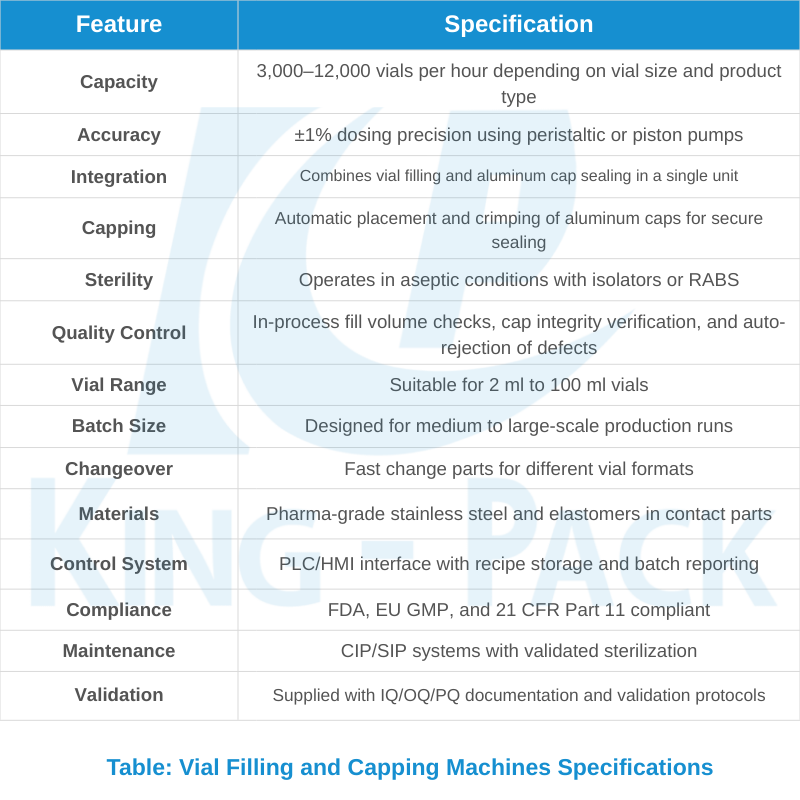
Key Features of Vial Filling Machines
Feature1: Precision Dosing and Filling
Contemporary pharmaceutical vial filling machines achieve remarkable accuracy through state-of-the-art dosing technologies. Servo-driven piston pumps deliver volumetric precision within ±0.5% deviation while peristaltic pumps provide contamination-free fluid paths ideal for sensitive biological products.
These systems incorporate real-time monitoring capabilities and automatic adjustment functions to maintain consistent fill volumes across extended production runs.

Precision dosing systems demonstrate remarkable adaptability to varying product viscosities and environmental conditions through programmable control parameters. Multi-head filling configurations enable simultaneous processing of multiple containers while preserving individual dose accuracy.
King Pack’s vial filling equipment including incorporates cutting-edge dosing technologies ensuring reproducible results throughout demanding production campaigns.
Feature 2: Sterility and Contamination Control
Contamination prevention represents a non-negotiable requirement for pharmaceutical vial filling equipment. Modern machines incorporate comprehensive barrier systems including laminar airflow protection, positive pressure environments, and automated cleaning cycles.
Sterilization protocols utilize steam, chemical sanitizers, or dry heat methods depending on product compatibility and regulatory specifications.
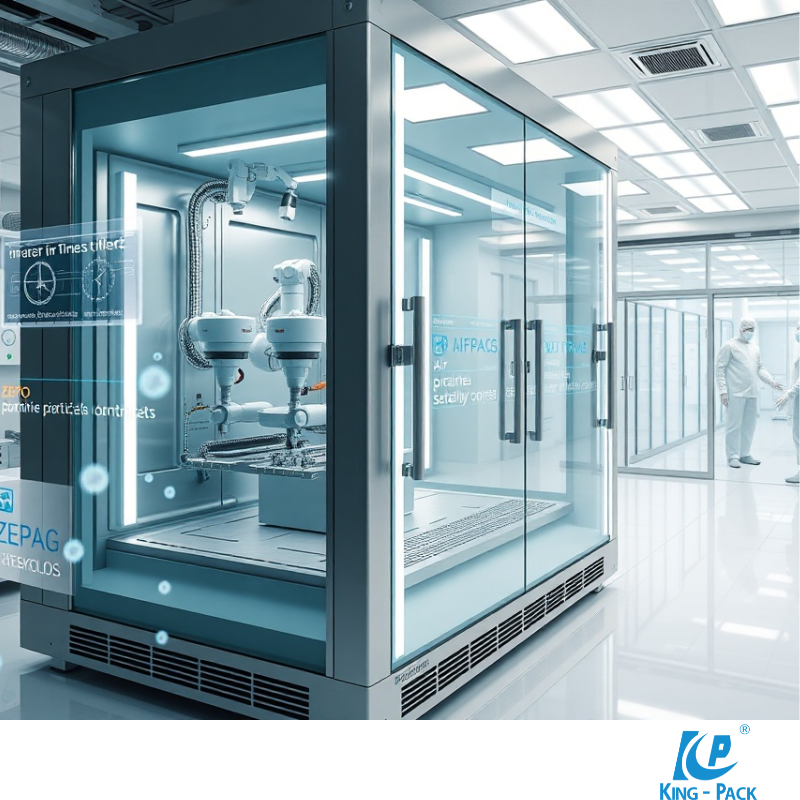
Advanced vial filling machines feature isolator technology creating completely enclosed processing environments that prevent external contamination while providing operator access through glove ports or robotic interfaces. Validation documentation includes comprehensive particle monitoring, microbial testing, and environmental mapping to demonstrate effective contamination control.
Feature 3: Speed and Production Capacity
Production speed requirements vary dramatically across pharmaceutical applications, spanning small clinical batches to commercial-scale manufacturing operations.
| Machine Type | Production Speed (vials/hour) | Typical Applications | Key Advantages |
| Semi-Automatic Vial Filler | 500 – 2,000 | Small batches, R&D, clinical trials | Flexibility, lower investment, easy changeover |
| Standard Automatic | 3,000 – 10,000 | Medium-scale production | Balanced speed/cost, reliable operation |
| High-Speed Automatic | 10,000 – 25,000 | Large-scale commercial | High throughput, integrated quality control |
| Ultra-High-Speed Systems | 25,000 – 36,000+ | Mass production, vaccines | Maximum efficiency, minimal manual intervention |
High-speed vial filling lines achieve exceptional output rates exceeding 600 vials per minute through optimized mechanical design and advanced control systems. These systems incorporate rapid changeover capabilities accommodating different container sizes and products without extended downtime.
Batch tracking systems carefully record production parameters including fill volumes, processing times, and quality measurements for each manufactured lot. Integration with enterprise resource planning systems enables real-time production monitoring and comprehensive inventory management.
King Pack designs vial filling equipment with scalable architectures accommodating future capacity expansion requirements.
Feature 4: Integration with Packaging Lines
Modern vial packaging machines integrate seamlessly with upstream and downstream equipment creating complete pharmaceutical packaging lines. These systems coordinate with vial washers, sterilization tunnels, labeling equipment, and case packaging machinery through programmable logic controllers and sophisticated communication networks.
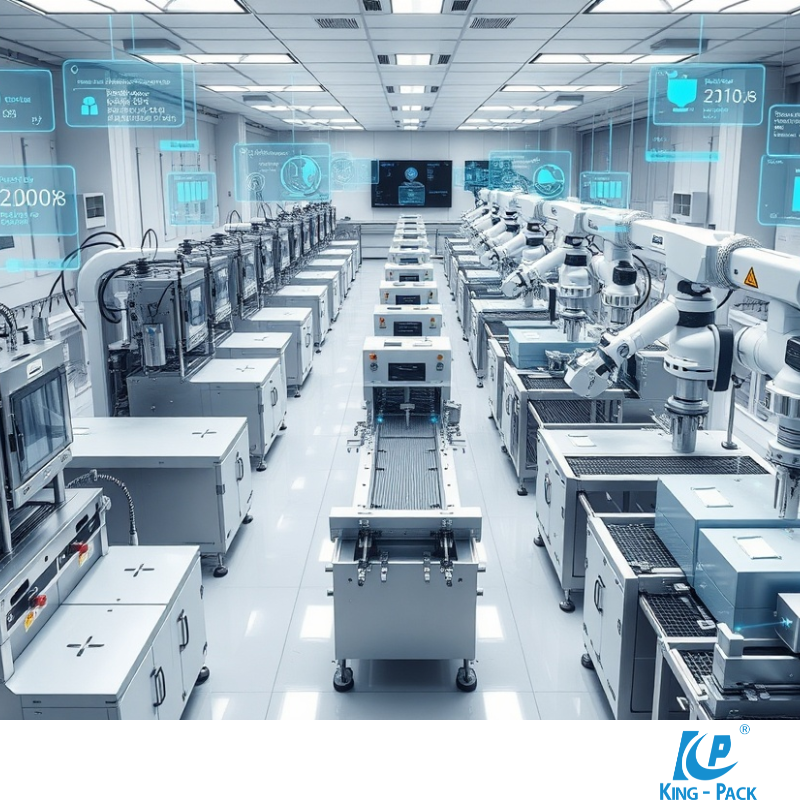
Integration capabilities encompass automatic format changeover, synchronized operation speeds, and centralized quality data collection. Vial filling lines incorporate buffer systems accommodating speed variations between different processing stations while maintaining continuous operation.
Applications of Vial Filling Machines
Pharmaceutical Liquids and Vaccines

Vial bottle liquid filling machine from King Pack Machine
Injectable pharmaceuticals constitute the primary application domain for vial filling equipment, encompassing diverse therapeutic categories:
- Antibiotic Solutions: Sterile injectable antibiotics requiring precise dosing and contamination-free processing
- Oncology Treatments: Potent cancer medications demanding specialized handling and containment systems
- Pain Management: Injectable analgesics and anesthetics for hospital and clinical applications
- Emergency Medications: Critical care drugs requiring rapid production capabilities and extended shelf life
Vaccine production necessitates specialized vial filling machines capable of handling temperature-sensitive biological materials while preserving potency and sterility. Cold chain management systems integrate with filling equipment to control product temperature during processing and storage. Recent global vaccine manufacturing initiatives have substantially increased demand for high-capacity sterile vial filling systems.
Biotech and Laboratory Solutions
Biotechnology companies use vial filling machines for advanced therapeutic products including protein therapeutics, monoclonal antibodies, and innovative gene therapy formulations. These applications frequently involve small batch sizes with extremely high product values, necessitating exceptional precision and sterility control.
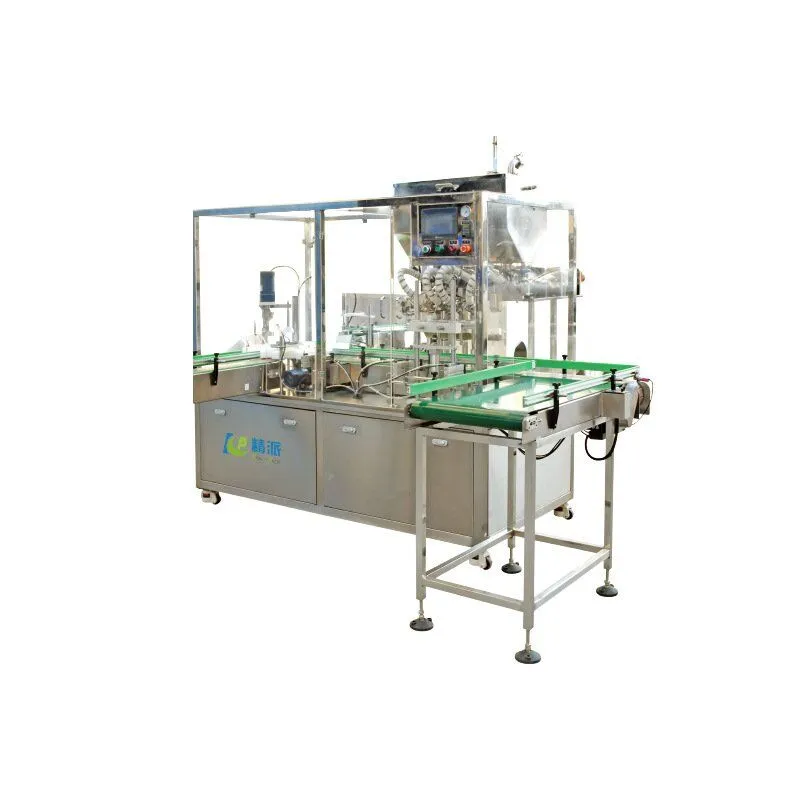
Laboratory applications encompass diagnostic reagents, reference standards, and research compounds requiring accurate dispensing into multiple vial formats. Automated vial filling equipment enables consistent sample preparation while reducing manual handling and potential contamination risks.
Cosmetic and Nutritional Products
The cosmetic industry employs vial filling machines for premium products including concentrated serums, essential oils, and specialized treatment formulations. These applications emphasize packaging aesthetics and product stability while maintaining filling accuracy for high-value cosmetic products.
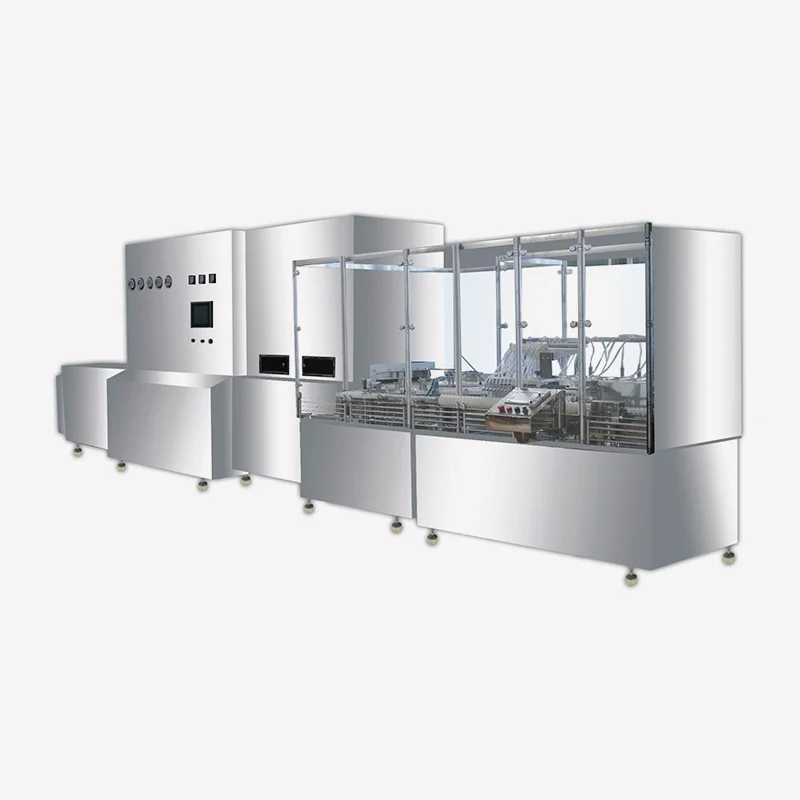
Vial bottle liquid washing and drying filling linkage line from King Pack’s Machine
Nutritional supplement manufacturers utilize vial filling equipment for liquid vitamins, herbal extracts, and specialized health products. King Pack provides versatile vial filling solutions accommodating the diverse requirements of cosmetic and nutritional applications while maintaining pharmaceutical-grade quality standards.
How to Choose the Right Vial Filling Machine
Production Volume and Batch Size
Production requirements represent the fundamental consideration when selecting appropriate vial filling equipment. Manufacturing scale directly impacts equipment selection criteria:
- Small-Scale Production: Batch sizes 100-5,000 vials requiring flexibility for frequent product changeovers
- Medium-Scale Operations: Batch sizes 5,000-25,000 vials balancing speed with operational flexibility
- Large-Scale Manufacturing: Batch sizes exceeding 25,000 vials demanding maximum efficiency and minimal changeover requirements
- Commercial Production: High-volume operations requiring 50,000+ vials per batch with continuous operation capabilities
Batch recording systems must accommodate comprehensive regulatory requirements for pharmaceutical manufacturing including electronic signatures, audit trails, and complete batch genealogy tracking.
King Pack provides scalable vial filling solutions accommodating both current production requirements and future growth projections.
Material Compatibility
Product compatibility significantly influences vial filling machine selection across multiple technical aspects including wetted parts materials, sealing systems, and cleaning protocols. Different pharmaceutical compounds present unique challenges:
- Corrosive Products: Require specialized materials such as Hastelloy or PTFE-lined components
- Biological Formulations: Necessitate single-use systems or materials withstanding aggressive sanitization
- Temperature-Sensitive Compounds: May require integrated heating or cooling capabilities
- High-Viscosity Products: Demand specialized pumping systems and heated product paths
Automation and Cleanroom Requirements
Cleanroom classification requirements directly impact vial filling machine design specifications and installation costs. Different environmental classifications demand specific equipment features:
- Grade A/B Processing: Specialized equipment with smooth surfaces and minimal particle generation
- Grade C/D Environments: Standard pharmaceutical equipment with enhanced cleaning capabilities
- Non-Classified Areas: Industrial-grade equipment suitable for non-sterile applications
- Isolator Integration: Advanced systems compatible with closed aseptic processing environments
Automation levels range from manual loading systems to fully automated lines incorporating robotic handling and integrated quality control systems. Higher automation levels provide improved consistency and reduced operator intervention while requiring greater initial investment and specialized maintenance expertise.
Maintenance and Cost Considerations
The total cost of ownership for vial filling and sealing systems goes beyond the upfront machine purchase. It also includes installation, validation, and day-to-day operational expenses that come with pharmaceutical production. For companies handling pharmaceutical ingredients and preparing for vaccine campaigns or clinical production, these costs can add up quickly if not planned for.
Key long-term factors include:
- Maintenance Programs: Preventive schedules keep liquid filling machines, pump systems, and servo drives running smoothly, reducing downtime.
- Utility Requirements: Power consumption, compressed air for pressure filling, and cooling systems all impact ongoing expenses.
- Consumable Materials: Replacement parts for filling heads, cleaning agents for sterile areas, and validation supplies are regular costs.
- Training Investment: Operators need to be trained not only on batch production methods but also on modern inspection systems, vial sealing machines, and closing machines.
Another critical aspect is Technical Support. Availability of spare parts, fast response times, and vendor expertise in ISO GMP Annex 1 compliance and environmental monitoring can be more valuable than a lower initial price.
Reliable vendors help optimize change over times, maintain GMP standards, and support add-on processes like freeze drying, laser printing, or Bottling & Capping. Over the full lifecycle of an aseptic filling machine, a trusted partner often saves more money than choosing the cheapest upfront option.
Conclusion
Vial filling machines have become a cornerstone of modern pharmaceutical and biotech production, ensuring accuracy, sterility, and compliance with strict global regulations. As demand for vaccines, biologics, and other injectable drugs continues to rise, the role of advanced filling systems will only grow stronger. Companies that invest in the right technology can achieve reliable output, minimize risks of contamination, and keep pace with expanding market needs.
Contact King Pack for Customized Vial Filling Equipment
Ready to enhance your pharmaceutical manufacturing capabilities with advanced vial filling equipment? King Pack specializes in tailored solutions designed to meet the unique needs of your production line.
Our range includes automatic, semi-automatic, sterile, stoppering, and capping machines, all built to deliver precision and consistency. Beyond the machines, King Pack offers expert guidance, installation support, and long-term service to ensure seamless operations.
Get in touch with us today to discuss your requirements and explore how our vial filling solutions can strengthen your production efficiency while maintaining the highest quality standards.




